BBC News, Yorkshire
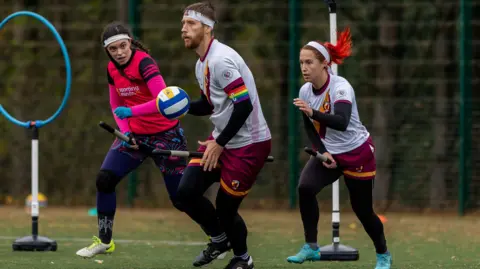 Giordano Di Pino-Forino
Giordano Di Pino-ForinoQuaffles, bludgers and the elusive golden snitch – it has been nearly 20 years since Quidditch moved from the pages of Harry Potter to real-life playing fields.
The sport, made famous by JK Rowling’s orphaned wizard, is now known as Quadball and believed to be the only mixed-gender, full-contact sport in the world.
Unlike Harry and co, who would perform hair-raising manoeuvres while soaring through the air on broomsticks, real-life players try to outwit their opponents astride PVC pipes.
While it may have originally been viewed as a sport for hardcore “Potterheads”, Quadball has long transcended the fictional series and carved out its own identity as a competitive sport which continues to keep thousands of players under its spell.
“I don’t even like Harry Potter,” says Sheffield Quadball Club player Henry Patten.
Henry discovered his love for the sport after reluctantly attending a training session in 2021.
“Sports I’ve been in before were all about competitiveness, trying to win at all cost,” the 22-year-old says.
“Quadball is just so much more about inclusivity and having a good time more than anything.”
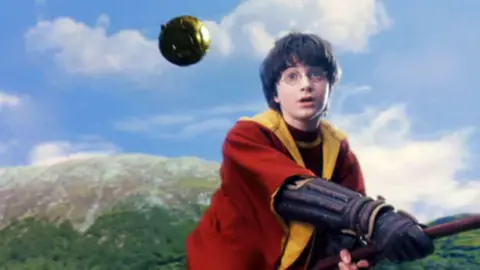 Warner Bros./Heyday Films/ALAMY
Warner Bros./Heyday Films/ALAMYRowling’s Quidditch is portrayed as a dangerous game, where players frequently endure high-speed collisions and aggressive tactics.
The real-life adaptation, created by students in the United States in 2005, is equally fast-paced and sees so-called chasers trying to throw quaffles – semi-deflated volleyballs – through the opposition’s hoops.
While doing so, they have to avoid being knocked out by bludgers, rubber dodgeballs thrown by beaters.
Perhaps the best-known element of the game is the golden snitch, famously very nearly swallowed by Harry Potter during his first-ever Quidditch match.
But instead of a winged, walnut-sized ball, real-life seekers chase a flag runner dressed in yellow, who has a sock with a tennis ball in attached to their shorts.
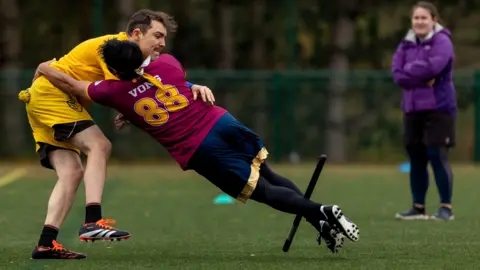 Giordano Di Pino-Forino
Giordano Di Pino-ForinoSarah Abramson, who plays for Bristol Quadball Club, says Quadball combines disciplines from well-known childhood favourites.
“It’s like if you play dodgeball, soccer and capture the flag all at the same time,” Sarah, who is from the US, says.
“It’s a really visually interesting sport to watch.”
Quadball teams usually comprise three chasers, two beaters, one keeper and one seeker, who play on a pitch roughly half the the size of football field.
Rather than buying a broomstick in Diagon Alley, it is store-bought PVC pipes players use to hold between their legs.
“It’s really fun but it’s also really silly,” Sarah, 25, says.
“You have to have the ability to laugh at yourself.”
Following its inception, Quadball quickly captured hearts and minds across the globe, leading to the emergence of new teams, tournaments and eventually the first World Cup in Oxford in 2012.
Unusual because of its rules and origin, players say being confronted with questions such as ‘oh, do you fly?’ and ‘is this even a real sport?’ is not uncommon.
Equally, people often underestimate how physically demanding the sport can be, says Chloe Durkin, the president of Olympians Quadball Club Leeds.
“A lot of people who do fitness for the sport say they do high-intensity interval training (HIIT) to put up with it,” they say.
Quadball has earned a reputation for being trans-inclusive and features a gender rule, which limits the number of players of the same gender on the pitch at the same time.
Chloe, who is also the international relations officer for governing body Quadball UK, says playing a mixed-gender, full-contact sport feels “empowering”.
“There is always this assumption that men are stronger than women, but in reality that’s not entirely true,” the 26-year-old says.
“There are lots of men in the community who would still find me a challenging opponent.”
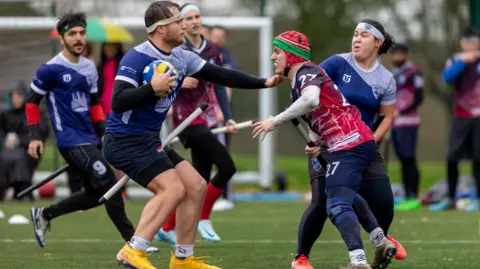 Giordano Di Pino-Forino
Giordano Di Pino-ForinoWhile Quadball’s links to the Harry Potter series are undeniable, the sport has taken active steps to move away from the franchise.
In 2022, the decision was made to rename Quidditch to Quadball, in part because of JK Rowling’s comments on gender identity but also due to trademark issues.
At the time, Quadball UK said the name change indicated “a firm stance with our trans players and members” and opened up “greater opportunities for funding”.
Sheffield Quadball Club player Izzy Hecks says the Harry Potter association is no longer “a marketing point” when it comes to recruitment.
“The books probably are a big factor why people know about the sport, but I’d like to think people are discovering it through other sources now.”
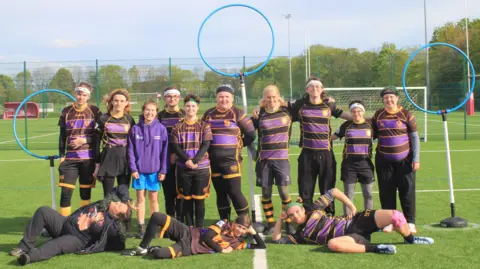 Sheffield Quadball Club
Sheffield Quadball ClubFor some players, like James Martin, Quadball presented an attractive alternative to other full-contact sports, like rugby.
The Warwick Quadball Club president and coach says: “It’s much more fun because you get a lot more of the ball and freedom of movement.
“I actually stopped playing rugby because I got much more into Quadball.”
Michael Ansell, who used to play American Football, says he signed up to the Oxford Mammoths in 2013 as “almost like a joke”.
“Looking back, it’s the best joke that I ever went through with,” the 30-year-old says.
“It’s the only sport I’ve ever played that you can turn up as a new person and you forget you didn’t know anyone before because they take you in so willingly.”
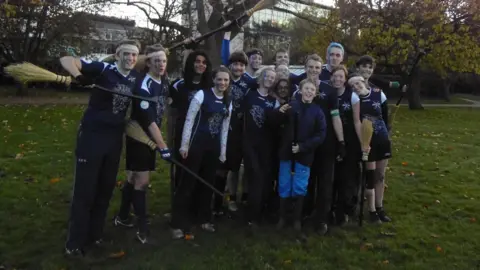 Sam
SamSince the coronavirus pandemic, recruitment has been challenging for both community and university teams, with some clubs even on hiatus.
Oxford Mammoths player Sam believes better collaboration between societies and targeting non-students could sustain growth.
Sam was 12 when he watched the British Quadball Cup in Oxford in 2012 and is now a proud player himself.
Despite the current challenges, the 23-year-old is optimistic about the future of the sport.
“I think we are struggling to figure out how to sell it, but I think it can be done,” he says.
“I refuse to believe that a whimsical sport like this is losing popularity.”
Listen to highlights from South Yorkshire on BBC Sounds, catch up with the latest episode of Look North or tell us a story you think we should be covering here.
Source link
Read More
Visit Our Site
Read our previous article: Real Madrid vs Girona predictions, odds and betting tips
Sports Update: . Stay tuned for more updates on How Harry Potter’s Quidditch became a real-life sport and other trending sports news!
Your Thoughts Matter! What’s your opinion on How Harry Potter’s Quidditch became a real-life sport? Share your thoughts in the comments below and join the discussion!
